Tri Mulyani, MPd, Widyaiswara LPMP Jawa Tengah,Abstract Tri Mulyani,2012. THE USING OF COHESIVE TIES IN EFL TEACHERS'RECOUNT TEXT WRITING: The Case of English Teacher Training in Central Java Educational Quality Assurance Institution( LPMP Jawa Tengah).Laporan Penelitian Pengembangan, diajukan dalam rangka kegiatan pengembangan profesi Widyaiswara. This study was conducted to investigate the correlation between the cohesive devices found in the recount text writings constructed by the participants of teacher training in LPMP. The research problems were :(1) What kinds of cohesive ties were used in the recount text writing of participants;(2) How frequently were cohesive ties used in the recount composition of the participants ;(3)Is there any relationship between the type of cohesive ties used and the quality of the same recount compositions;(4) Does the using of reference ties show a relationship with the quality of the recount writing:(5)Does the applying of reference and conjunction ties correlate with the quality of the recount writing.
This research design is correlation. Twenty essays were collected and then analyzed by applying the frameworks of Halliday and Hasan (1976). In assessing the writing achievement, the ESL Composition Profile was used.
The findings show (1) all categories of cohesive devices were found in the participants' writings. (2)The reference category had the highest percentage of ties (55.5%), followed by the conjunction category (37.6%) then ellipsis category (5.1%), next substitution category (1.3%) and the last lexical category (0.6%). (3)The result of computation using Pearson formula shows that there is a high correlation between the number of cohesive ties and the quality of writing. The correlation coefficient of 0.71 at the significance level 0.05. It means that using cohesive ties contribute 71% to the quality of writing, and the rest is from the other factors.(4) The statistic computation result shows that there is no correlation between using of reference and the quality of writing.(5) The calculation also shows that the using of reference and conjunction has a correlation with the quality of writing.
The conclusion of the study reveals that the using of the number and kinds of cohesive ties has a high relationship with the quality of writing.
It is suggested that teachers should introduce all kinds of cohesive ties when they are teaching. It is expected that, with the integration of reading and writing, EFL learners would become aware of and more sensitive to the characteristic features of good English writing.
Key words: cohesive devices, recount writing Background of the study
There is no doubt that writing is one of the most difficult skills for foreign language learners to master. The difficulty lies not only in generating and organizing ideas, but also in translating these ideas into readable text. The skills involved in writing are highly complex. Second language learners' writers have to pay attention to higher-level skills of planning and organizing as well as lower level skills of spelling, punctuation, word choice and so on.
The main focus of this research is expressing opinions at the paragraph level. Therefore, paragraph writing or the organization of a paragraph is of primary importance. However, writing builds larger units from smaller ones; that is, writers use words to make sentences, sentences to make paragraphs, and paragraphs to make compositions.
Reasons for choosing the topic
This study is special from all of the previous researches because it examined the product of writing from the teachers. I try to find if teachers write text cohesively or not because teachers' compositions become the model of their participants' writing.
From my own experience in assigning participants to write out a certain topic, learners found some problems. It was very hard to construct an organized and coherent written text in English. When they did write a connected text or a composition, difficulties at the discourse level occur. For examples, on the organizational level, others involved poor topic continuance, inadequate use of examples and details, limited vocabulary, and the poor or inadequate use of cohesive devices. The last category, that is the use of cohesive devices is the concern of this study.
A number of studies on cohesion were done by several EFL practitioners. Zhang Meisuo from Xinzhou Teachers' college of China conducted research on cohesion analysis. The result of the study shows that participants employed in their writing various types of cohesive devices with some categories of ties used more frequently than the others did.
Inspired by the above research and some others, I am interested in doing this research for some reasons. First, there hasn't been such kind of research ever conducted in my institution, yet. Secondly, all researchers who examined cohesive features focused on participants' writing only, but I spotlight my research on teachers' writing. Thirdly, I hope the research findings will be useful as an attempt to improve the quality of teaching writing.
Statement of the Problems
The main problem of the study was conceptualized in terms of the following three research questions:
(1) What kinds of cohesive ties were used in the recount text writing of participants of teacher training in Central Java Educational Quality Assurance Institution?
(2) How frequent were for each type of cohesive ties used in the recount text composition of the participants of English teacher training in LPMP Jawa Tengah?
(3) Is there any relationship between the number of cohesive ties used and the quality of the same recount compositions?
(4) Does the using of reference ties show a relationship with the quality of the recount writing?
(5) Does the applying of reference and conjunction ties correlate with the quality of the recount writing ?
Purpose of the Study
The purpose of the study is to examine:
- the kinds of cohesive ties used in the recount writing of the participants of English teacher training in LPMP Jawa Tengah;
- the frequency each type of cohesive ties used in the recount writing of the participant;
- the relationship between the cohesive ties used and the quality of the
same recount composition;
the correlation between the using of reference tie and the quality of writing;
- the correlation between the using of reference and conjunction ties to the quality of writing.
Review of Related Literature
Cohesion has been defined in a number of ways. Widdowson (1982: 52-55) defines it in terms of the distinction that is made between the illocutionary act and the proposition. In his view , propositions, when linked together, form a "text" whereas illocutionary acts, when related to each other, create different kinds of "discourse." According to Halliday (Halliday 1994: 309–311), cohesion is the set of language resources which express relationships or links through a text or discourse separate from the structural level of sentence grammar.
Halliday and Hasan recognize five types of cohesive devices in English and in the lexicogrammatical system of the language. They are reference, substitution, ellipsis, conjunction, and lexical cohesion. Reference, substitution, and ellipsis are grammatical; lexical cohesion is lexical; conjunction stands on the borderline between the two categories. In other words, it is mainly grammatical but sometimes involves lexical selection.
Theoretical framework
Halliday and Hasan's ( 1976) model is selected as the most comprehensive framework for the analysis of the cohesive features in participants 'writing. The coding system is used to account for and quantify the ties and the tie distance. The model with its detailed coding system helped the researcher to establish a relationship between the cohesive features and the quality of writing as determined on a particular marking scheme and, therefore, ensured to a large extent the objectivity and reliability of the study.
Hypothesis
There were three null hypotheses to be tested:
Hol: There is a relation between the using of cohesive ties and quality of writing.
H02: There is a relation between the using of reference ties and quality of writing.
H03: There is a relation between the using of reference and conjunction ties and quality of writing.
The dependent variable is the frequency of cohesive ties; the independent variable is the quality of writing.
Methods of Investigation
This study was any kind of discourse analysis. It investigated the use of cohesive features in the recount writing text of participants of teacher training of the Educational Quality Assurance Institution in Central Java (LPMP Jawa Tengah), using both quantitative and qualitative methods. Twenty essays were collected from participants of teacher training in Central Java Educational Quality Assurance Institution(LPMP Jawa Tengah) and assessed by two raters. Halliday and Hasan's (1976) taxonomy of cohesive devices and their framework for analysis were used.
Method of data collection
The method of data collection in this study consists of subject of the study, data collection and instrument
Subject of the study
The subject of the study is the recount compositions of participants of teacher training in Central Java Educational Quality Assurance Institution. I collected the compositions from all of 20 participants of Secondary school teacher training participants in LPMP of Semarang Central Java.
Data Collection
The data collection took place on December 16, 2010. Each participant was asked to write an essay of recount. The topic was free. They were asked to write within 45 minutes an essay of about 150 words at one sitting and under the same conditions.
Instrument
A composition test is used as the instrument of data collection. It is the most direct and suitable way of measuring participants 'writing ability ( Harris, 1969:69). The composition test requires participants to organize their own essays, express their own ideas and words so that the last measures what it is intended to measure. Methods of data Analysis
I collected compositions from 20 participants of the ToT program in LPMP.
Each participant wrote one essay. S/he was free in choosing the topic. I asked them to write within 45 minutes an essay of about 150 words at one sitting. Then, I analyzed the compositions of cohesion by counting cohesive ties in accordance with the well- developed taxonomy of cohesive devices provided in Halliday and Hasan (1976). The essays were analyzed for cohesive ties after the marking, following these procedures:
1) Cohesive devices were identified and classified under the appropriate headings on the cohesive analysis sheet. The coding form captured the following data:
- index-serial number of each sentence in ascending order;
- each cohesive item with a code identifying the sub-category to which it belongs;
- the referent (or the presupposed item) of the particular cohesive item;
(Cohesive items without referents were to be coded but not included in the frequency count.)
- the number of cohesive ties used in a particular essay;
- any special features in the use of cohesive devices or any other remarkable linguistic features.
All this information was believed to be necessary in determining whether there would be a relationship between the quality of writing and the number of ties used in the essays.
2) The same set of essays was also analyzed qualitatively.
Next, for statistical analysis, I computed the data using descriptive statistics and later inferential statistics ( e.g. Pearson's correlation). The later was applied to assess the degree of the relationship between the frequency of use of cohesive ties and the quality of the compositions as determined by a marking scheme entitled ESL Composition Profile (rubric of writing).
Marking Scheme
The EFL composition profile devices writing into five components with various percentages, i.e. content (30%) organization (20%), vocabulary (20%), language use ( 25%) and mechanics ( 5%). Each has a set of criteria ranging from "excellent to very good" to "very poor" with a specified range of scores. The profile assumes 100 as the highest possible scores for overall proficiency in English composition. The two raters did the scoring of the essays. The raters were members of the English trainee.
Controls in the Study Design
Criteria were set to control variables such as the writing environment, inter-rater reliability in essay assessment and extracts of texts for analysis to control possible factors that might otherwise affect the results of the study.
Writing Environment
For purposes of comparability, the writing environment and the procedure for data collection were made uniform for both groups of participants.
~Essay type: Participants had to write their essays in the recount mode
~Essay topic: Participants were required to choose on topic he/she wants
~Essay length: Participants were asked to write a composition of about 150 words.
~Writing duration: A total of 45 minutes was given to the participants for the completion of the completely writing task. This was to ensure that subjects wrote individually under identical conditions.
Inter-rater Reliability
The essays, which collected from the participants, were graded on the Profile Scheme by two independent raters. Each essay was given two grades. One was numerical and the other letter grade which was converted from the original numerical score. In order to ensure consistency in the grading for this particular study, the results of grading were checked for inter-rater reliability.
Findings
This finding describes about kinds of cohesive ties that are used by the participant of English teacher training in LPMP, the frequency of cohesive ties and the using of cohesive in relation to the quality of writing.
1) Kinds of cohesive ties
A preliminary analysis of the raw data using descriptive statistics shows that the teachers in this study employed all types of cohesive devices. Some categories of ties used more frequently than the others. Based on the percentage of ties of each cohesive category it was found that the reference category had the highest percentage of ties (55.5%), followed by the conjunction category (37.6%) then ellipsis category (5.1%), next substitution category (1.3%) and the last lexical category (0.6%).
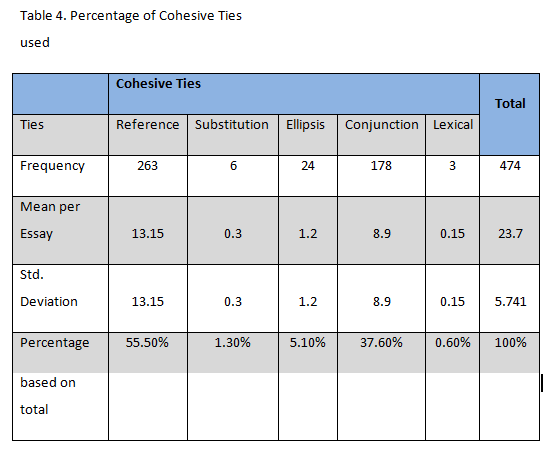
The complete description of cohesive ties used is displayed in Table 5. below.
Table 5. Description of cohesive ties
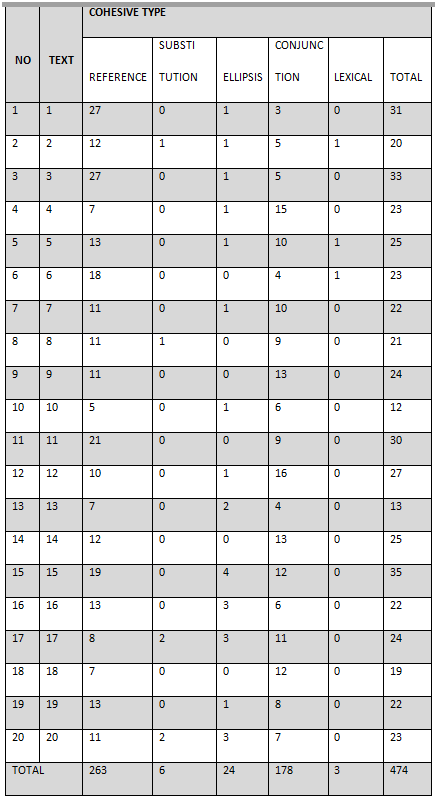
2) Frequency of cohesive ties that used in the recount composition
The same set of essay was also analyzed in order to discover more about the pattern of use of cohesive devices. The result of the analysis will be presented in the order of cohesive categories: Reference, Substitution, Ellipsis, Conjunction, and lexical
a. Use of reference
In the three categories of reference ties, pronouns formed the largest percentage of use, followed by demonstratives and then comparatives, as shown in Table 6.
Table 6. Reference Ties in Sub-categories
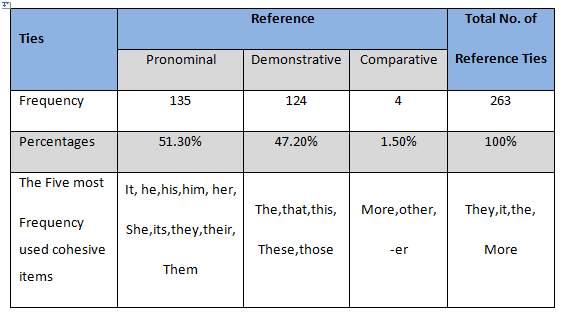
It is worth noting that of the three sub-categories of reference ties, comparatives were the least used across all grades. This may suggest that the participants were weak in this area and had difficulty in using such comparative expressions.
b. Use of Ellipsis
In the three sub categories of ellipsis ties, clausal ties formed the largest percentage of use, followed by nominal ties as shown in table 7
Table 7. Ellipsis Ties in sub categories
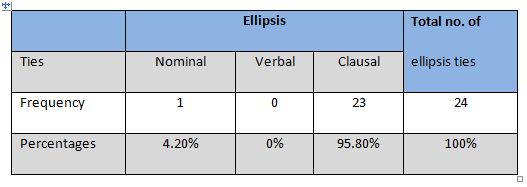
The qualitative analysis suggested that the participants were general weak in ellipsis ties because most participants used zero elliptical clause functioning as WH-question and answer.
c. Use of substitution
In the three sub categories of substitution ties, nominal formed the largest percentage of use, followed by verbal ties, as shown in Table 8.
Table 8.Use of substitution
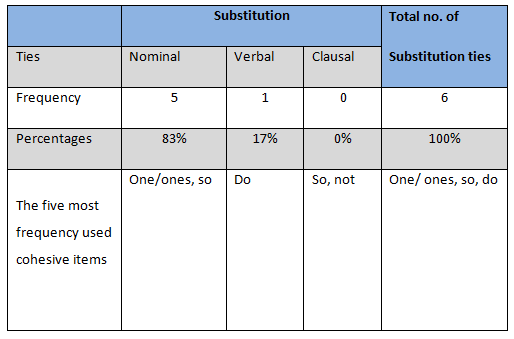
The participants' rarely use of substitution might have been caused by the fact that applying correct and accurate substitution requires a more understanding of English grammar.
d. Use of Conjunction
In the five sub categories of conjunction ties, temporal and additives ties formed the largest percentage of use, followed by adversative and then clausal ties, as shown in Table 9.
Table 9. Use of conjunction
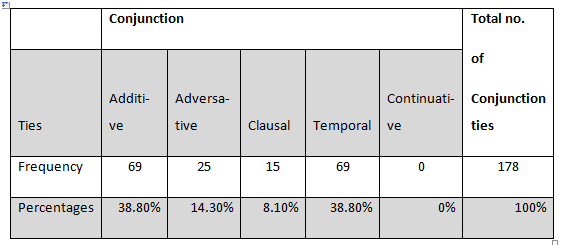
A glance at Table 9 above seems to indicate that all writers were aware of the range of sub-categories in the conjunctive device. However, it was found in the qualitative analysis that conjunctions were not always used effectively or correctly in the essays. The features were mainly in two areas (1) overuse and misuse of additives (and, also, besides) and temporal (first, first of all, secondly, thirdly, finally), and (2) misuse of adversatives (but, however, on the other hand).
e. Use of lexical
In the five categories of lexical ties, participants only used synonym, as shown in table 10.
Table 10.Use of lexical
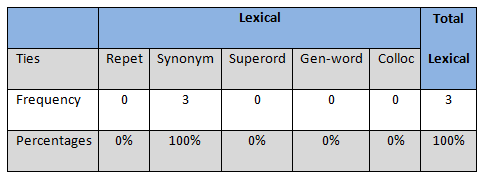
The qualitative analysis suggested that the participants were in general weak in lexical cohesion and had some difficulties in using the correct wording. The lexical ties used are just hyponymy (as we see in the example below). It shows the participant had low and limited lexical mastery.
3) Result of the Writing Assessment
The essays were, then, assessed independently by two raters. The reliability of the two raters in the assessment was calculated on the Alpha formula.
The combined scores of the two raters are used as a reference for the overall participants' performance in writing. The assessment result is presented in the following table.
Table 11: scores of the recount writing
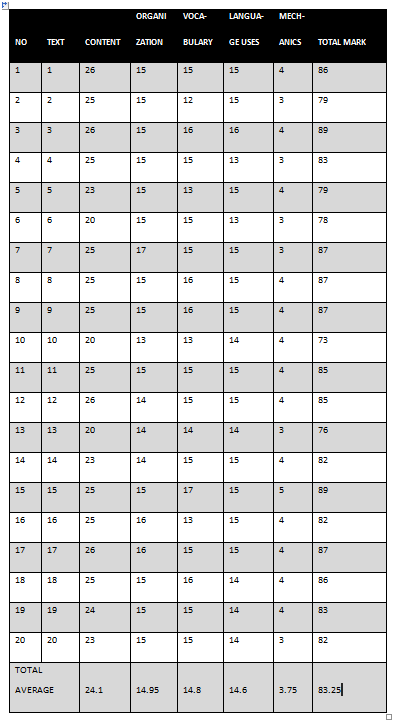
From table 11 we can infer that the participants' writing quality is relatively good with the mean score 83.25. The minimum score is 73, which is achieved by the writer of text #10, and the maximum score is 89, achieved by the writer of text #3 and #15. The means of the components of the profile i.e. content, organization, vocabulary, language use, and mechanics are 24.1, 14.95, 14.8, 14.6 and 3.75 respectively.
Table 12 helps us to interpret the scores from a different point. The figure exhibits the score means of the two variables in the study.
Table 12. Descriptive statistic score and cohesive ties used

The mean of the writing scores is 83.25 while the mean of cohesive ties used is 23.7. The maximum score for writing is 89 whereas the minimum is 73. So, the range is 16. The maximum use of cohesive ties is 35 while the minimum is 12, and the range shows 13. It indicates that participants writing scores are varied compared with the number of cohesive ties used by individual participants. The individual writing achievement can be seen in figure 1 below
Figure1.Scores of the essays

3. Use of cohesive in relation to the quality of writing
A major objective of the study was to investigate the relationship between the number of ties used and the quality of writing. Here, The researcher compares the mark and the number of cohesive ties which is shown from the table below
Table 13. The use of cohesive ties and the score
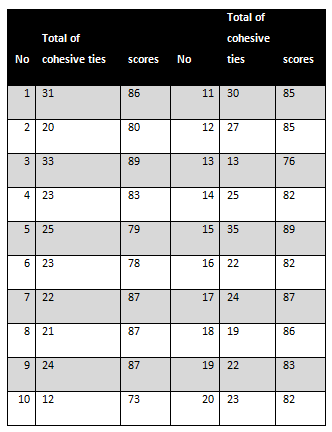
The result of correlation was computed between the numerical essay scores and the number of cohesive ties through the use of Pearson Product Moment formula.
Table 14. correlation between score and cohesive ties
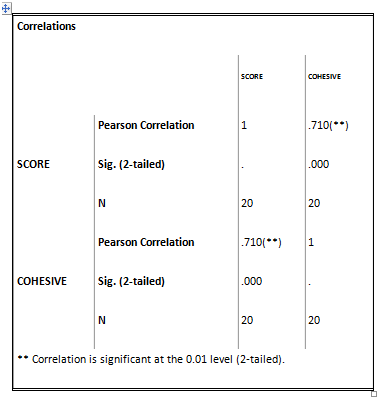
The first null hypothesis is accepted. It means that there is a correlation between the using of cohesive ties and quality of writing. The index of the correlation is .710. It indicates a high correlation between two variables.
4) The correlation between the using of reference ties and the quality of writing
Another purpose of the study was to investigate the correlation between the using of reference ties and the quality of writing.
Table 14. Correlation between reference ties and the quality of writing.

The second null hypothesis is rejected .It means that there is no correlation between the using of reference ties and quality of writing. The significant ( two tailed) is 0.75. It's higher than 0.01. It indicates that there is no correlation between the using of cohesive ties and the quality of writing.
5. Correlation between reference and conjunction to the quality of writing.
This research was also to examine the correlation between the using of reference and conjunction ties and the quality of writing. The following table represents the result of calculation.
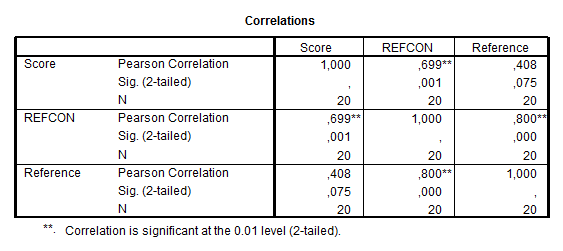
Table 15. The Correlation between the using of reference and conjunction and the quality of writing.
The third hypothesis is accepted. It means that there is a correlation between the using of conjunction and reference and the quality of writing. The significant
( two tailed) is .000. It is below 0.01 so, the indication is there is a correlation between the using of reference and conjunction with the quality of writing.
Discussion of the findings
The analysis of cohesive devices used in twenty texts shows that reference category is mostly used the participants recount writing. 55.5% of the total uses of cohesive are reference. However, too much repetition, particularly in short sentences makes the paragraph choppy, not interesting to the readers. This suggests a general pattern of recount writing that in such a genre the involvement of participants consistently along the text was logical. From the correlation matrix, it is found that there was a statistically significant relationship between the number of cohesive ties used and the quality of writing. This finding seems to suggest that the number of cohesive ties could be a reliable indicator of the quality of writing. This finding is supported by Witte,S.P and Faigley.F (1981), Yang, A.W. (1989), and Norment, N.(1994) as cited by Meisuo (2000:61).
In the qualitative analysis, it is found that the use of ellipsis, substitution and lexical is weak area and requires more attention in both teaching and learning especially for EFL learners. Apart from the difficulty, it also demonstrates some difficulty in writing sentence with various constructions. This tendency may be influenced by mother tongue language, the Indonesian language.
The calculation answer about the correlation between the using of reference ties and the quality of writing shows that the significant( two tailed) is 0.75. It's higher than 0.01. It indicates that there is no correlation between the using of reference ties and the quality of writing.
The computation result comparisons result about the correlation between the using of reference, conjunction and the quality of writing shows that the significant( two tailed) is .000. It indicates that there is a correlation between the using of cohesive ties and the quality of writing
Pedagogical Implication
The findings of the this study have the following implications for the teaching and learning of English writing.
Firstly, most the participants of teacher training in LPMP have difficulties in using cohesive devices effectively and accurately, it is necessary that the instructors/ facilitators of writing should focus the lesson in this regard. Focused lesson should be aimed at improving systematically the common features of various cohesive ties, not only on certain types of cohesive.
Secondly, teachers should introduce cohesive ties when they are teaching. It is also needed to bring in all kinds of cohesive ties in order to make learner write text well.
Thirdly, teachers should be encouraged (1)to learn new words in their contexts of use rather than from isolated lists;(2) to use English-English dictionaries, and better still, the thesaurus instead of predominantly English- Indonesia dictionaries, and (3) to learn to paraphrase words/ phrases by means of synonyms, antonyms, hyponyms or examples rather than word-for-word translations.
Conclusions and Suggestions
In light of the result of the study and discussion of the result there are five conclusions can be drawn
- All categories of cohesive devices were found in the participants' writings, i.e. reference, conjunction, ellipsis, substitution and lexical ties.
- The reference category had the highest percentage of ties (55.5%), followed by the conjunction category (37.6%) then ellipsis category (5.1%), next substitution category (1.3%) and the last lexical category (0.6%).
- From the correlation matrix, it is found that there is a significant correlation between the number of cohesive ties used and the quality of writing. The computation of Pearson Product Moment correlation by using SPSS reveals that correlation coefficient is high and it is significant. It implies that the number of cohesive ties is an important factor in relation of the quality of writing.
- The computation result about the using of reference ties and the quality in writing shows that there is no correlation between two factors above.
- The calculation shows that the using of reference and conjunction has a correlation with the quality of writing.
Owing to various constraints, this study on the cohesive features used in this study experiences certain limitation, method and general ability. The findings, therefore cannot be generalized to writing all other EFL teachers.
Suggestion
The suggestion is concerned with the integration of the teaching of lack writing and reading. It is noted that most EFL learners generally lack the knowledge and awareness of how cohesive devices should be used, which may suggest that there is a gap between the teaching of reading and the teaching of writing in other words there is much less integration between these two courses. It is expected that, with the integration of reading and writing, participants would become aware of and more sensitive to the characteristic features of good English writing.
REFERENCE
Baker,M. 1992. In Other Words: A Course Book of Translation. London. Routledge.
Bram,B.1995. Write Well. Yogyakarta. Kanisius
Butt,D. et al.1995. Using Functional Grammar. Sidney. Macquire University
Connor, U. 1984 A Study of Cohesion and Coherence in English as a Second Language Students' Writing. Papers in Linguistics: International Journal of Human Communication vol 17:3, pp 301-316
Crewe, W. 1990. The Illogic of Logical Connectives. ELT Journal vol 44:4 pp 316-325
Cushing, Sara.2009. Assessing Writing. Cambidge. Cambridge University Press.
Devitt.J. Amy. Writing Genre,New York, Illinois University Press, 2004
Eggins, S.1994. An Introduction to Systemic Functional Grammar. London: Pinter Publisher Ltd.
Field,Y.1994. Cohesive Conjunctions in The English Writing Of Cantonese Speaking Students From Hong Kong. Australian Review Of Applied Linguistics vol 17:1, pp 125-139
Field, Y. and Yip,L.M.O. 1992. A Comparison of Internal Conjunctive Cohesion in The English Essay Writing of Cantonese Speakers and Native Speakers of English. RELC Journal vol 23:1, pp 15-28
Gutwinski, W. (1976). Cohesion in Literary Texts: A Study of Some Grammatical and Lexical Features of English Discourse. The Hague: Mouton.
Gerot,L. and P. Wignell. 1994. Making Sense of Functional Grammar. Sidney. Antipodean Educational Enterprises
Halliday M.A.K and Hasan.1976. Cohesion in English. London: Longman
Halliday M.A.K and R. Hasan.1976. Cohesion in English. London: Longman
Halliday. M.A.K. 1985. Spoken and Written Language. London. Oxford University Press
Halliday, M.A.K. 1989. Language, Context, and Text
: Aspect Of Language In Social Semiotic Perspective. Victoria: Deakin University
Halliday, M.A.K. 1994. An Introduction to Functional Grammar. London:
Edward Arnold
Halliday, M.A.K. & Matthiessen, C.M.I.M. (2004). An Introduction to Functional Grammar (3rd Ed.). London: Arnold.
Harris,D.P.1969. Testing English as a Second Language. New York. Mcgraw-Hill,Inc.
Harmer, J.1999. How to Teach English. New York: Longman
Ho, Wah Kam, 1973. An Investigation of Errors in English Composition of Some Pre-University Students in Singapore, with Suggestions for The Teaching of Written English. RELC Journal vol 4:2, pp 48-65
Hughey,V.F., et al. 1985. Learning ESL Composition. Principles and Techniques. Cambridge : Newbury House Publishers.
Hyland, K. 2002. Teaching and Researching Writing. London: Pearson Education.
Jacobs, H.L.,Zingraf S.A, D.R. Wourmuth, V.F.Hartfield, And P.B. Hughey. 1981 Testing EFL Composition; A Practical Approach. Massachusetts: Newbury House Publisher
Johns, A.M. 1984. Textual Cohesion and The Chinese Speakers of English. Language Learning and Communication vol 3:1, pp 69-73
Johnson,P.1992. Cohesion and Coherence in Compositions in Malay and English Language. RELC Journal vol 23:2, pp 1-17
Martin, J.R. (2001). Cohesion and Texture. in D. Schiffrin, D. Tannen & H.E. Hamilton (Eds.), Handbook of Discourse Analysis. Malden, MA: Blackwell. Pp. 35–53
Mcdonough,J.And C. Shaw. 1993. Materials and Methods in ELT. Blackwell Publishers
Mcgregor, W. (1990). A Functional Grammar of Gooniyandi. Amsterdam: John Benjamins.
Meizuo Zhang.2000. Cohesive Features in the Expository Writing of Undergraduate Participants in Two Chinese Universities. RELC Journal Vol 31.pp 61-93
Norment,N.1994. Contrastive Analyses of Cohesive Devices in Chinese and Chinese ESL in Narrative and Expository Written Texts. Chinese Language Teaching Association Journal vol 29:1, pp 49-81
Nunan,D. 1991. Language Teaching Methodology: A Textbook for Teachers. London: Prentice Hall International
Nunan,D. 1999. Second Language Teaching and Learning. Massachusetts: Heinle & Heinle Publishers
Reid,M.J.1993. Teaching EFL Writing. New Jersey: Prentice Hall
Swales,J.M. 1990. Genre Analysis. New York : Cambridge University Press
Tierney, R.J. and Mosenthal, J.H. 1983. Cohesion and Textual Coherence Research in Teaching of English vol 17 :3, pp 215-229
Wang, Jinghui, Xin. Minjie and Wan,Jing,1993.
Computer-Assisted Instructions for English Writing. Foreign Language World vol 23, pp 14-16
Wong, Ruth Yeang Lam.1992. Strategies for The Construction of Meaning. Toronto. University of Toronto
Yang, Yuchen and Wen. Zhaoyun.1994. Sentence Patterns in English Composition Written by Chinese Students. Modern Foreign Language vol 63. pp 39-42

Tidak ada komentar:
Posting Komentar